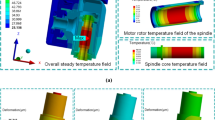Abstract
Results from the temperature field and thermal deformation simulation of a spindle system are greatly affected by the accuracy of convective heat transfer coefficients (CHTCs). This paper presents a new method based on radial basis function (RBF) neural network to calculate CHTCs. First, the temperature field and thermal deformations of a spindle system were obtained by experimental and finite-element (FE) methods. However, the simulation results are significantly different from the experimental results because boundary conditions used for the FE model were derived empirically. Second, the relationship between the simulated temperature values and CHTCs were established by a RBF neural network. Using the experimental temperature values as an input vector of the RBF neural network, CHTCs of the spindle system can be predicted through an iterative calculation taking 14 cycles. Finally, the effectiveness of the proposed method was proved using steady-state and transient-state analyses of the spindle system. Results from the steady-state simulation show that temperature errors were less than 4 % at the seven thermal-critical points and deformation errors in the three directions were less than 6 %. Results from the transient-state simulation of the spindle system show that the variations for each of the thermal characteristics are in good agreement with the experimental results. The method provides guidance for modifying boundary conditions of a FE model.
Similar content being viewed by others
References
Liang RJ, Ye WH, Zhang HH, Yang QF (2012) The thermal error optimization models for CNC machine tools. Int J Adv Manuf Technol 63(9–12):1167–1176
Han J, Wang LP, Cheng NB, Wang HT (2012) Thermal error modeling of machine tool based on fuzzy c-means cluster analysis and minimal-resource allocating networks. Int J Adv Manuf Technol 60(5–8):463–472
Wu H, Zhang HT, Guo QJ, Wang XS, Yang JG (2007) Thermal error optimization modeling and real-time compensation on a CNC turning center. J Mater Process Technol 207(1–3):172–179
Creighton E, Honegger A, Tulsian A, Mukhopadhyay D (2010) Analysis of thermal errors in a high-speed micro-milling spindle. Int J Mach Tools Manuf 50(4):386–393
Mori M, Mizuguchi H, Fujishima M, Ido Y, Mingkai N, Konishi K (2009) Design optimization and development of CNC lathe headstock to minimize thermal deformation. CIRP Ann Manuf Technol 58(1):331–334
Chen TY, Wei WJ, Tsai JC (1999) Optimum design of headstocks of precision lathes. Int J Mach Tools Manuf 39(12):1961–1977
Harris TA (1991) Rolling Bearing Analysis. John Wiley and Sons, New York
Xu RP, Feng HD, Zhao LP, Xu L (2006) Experimental investigation of thermal contact conductance at low temperature based on fractal description. Int Commun Heat Mass 33(7):811–818
Zhao HL, Huang YM, Xu JL, Jiang LY, Zhang WH, Sheng BH (1999) Experiment research on thermal contact resistance of normal used joints. J Xi’an Univ Technol 15(3):26–29 (in Chinese)
Ciavarella M, Dibello S, Demelio G (2008) Conductance of rough random profiles. Int J Solids Struct 45(3–4):879–893
Baïri A, Laraqi N (2005) Heat transfer across a solid-solid interface obtained by machining in a lathe. J Mater Process Technol 169(1):89–93
Neugebauer R, Ihlenfeldt S, Zwingenberger C (2010) An extended procedure for convective boundary conditions on transient thermal simulations of machine tools. Prod Eng 4(6):641–646
Yang ZY, Sun ML, Li WQ, Liang WY (2011) Modified Elman network for thermal deformation compensation modeling in machine tools. Int J Adv Manuf Technol 54(5–8):669–676
Jiang SY, Mao HB (2010) Investigation of variable optimum preload for a machine tool spindle. Int J Mach Tools Manuf 50(1):19–28
Chen DJ, Bonis M, Zhang FH, Shen D (2011) Thermal error of a hydrostatic spindle. Precis Eng 35(3):512–520
Wu JY, Li HL (2010) Method for improving FEA accuracy for CNC spindle system thermal characteristics. Tool Eng 44(3):30–33 (in Chinese)
Fan CL, Sun FR, Yang L (2008) A numerical method on inverse determination of heat transfer coefficient based on thermographic temperature measurement. Chin J Chem Eng 16(6):901–908
Rebay M, Arfaoui A, Mebarki G, Maad RB, Padet J (2010) Improvement of the pulsed photothermal technique for the measurement of the convective heat transfer coefficient. J Therm SCI 19(4):357–363
Xu M, Jiang SY, Cai Y (2007) An improved thermal model for machine tool bearings. Int J Mach Tools Manuf 47(1):53–62
Yu ZP, Lu Y (1995) Heat transfer theory. Higher Education Press, Beijing
Kitayama S, Kita K, Yamazaki K (2012) Optimization of variable blank holder force trajectory by sequential approximate optimization with RBF network. Int J Adv Manuf Technol 61(9–12):1067–1083
Chen T (2012) The FLR-PCFI-RBF approach for accurate and precise WIP level forecasting. Int J Adv Manuf Technol 63(9–12):1217–1226
Zhang PY, Lü TS, Song LB (2005) RBF networks-based inverse kinematics of 6R manipulator. Int J Adv Manuf Technol 26(1–2):144–147
Zhang HT, Yang JG, Zhang Y, Shen JH, Wang C (2011) Measurement and compensation for volumetric positioning errors of CNC machine tools considering thermal effect. Int J Adv Manuf Technol 55(1–4):275–283
Chen L (2008) Study on prediction of surface quality in machining process. J Mater Process Technol 205(1–3):439–450
Lu C, Ma N, Chen Z, Costes JP (2010) Pre-evaluation on surface profile in turning process based on cutting parameters. Int J Adv Manuf Technol 49(5–8):447–458
Author information
Authors and Affiliations
Corresponding author
Rights and permissions
About this article
Cite this article
Li, D., Feng, P., Zhang, J. et al. Calculation method of convective heat transfer coefficients for thermal simulation of a spindle system based on RBF neural network. Int J Adv Manuf Technol 70, 1445–1454 (2014). https://doi.org/10.1007/s00170-013-5386-y
Received:
Accepted:
Published:
Issue Date:
DOI: https://doi.org/10.1007/s00170-013-5386-y




